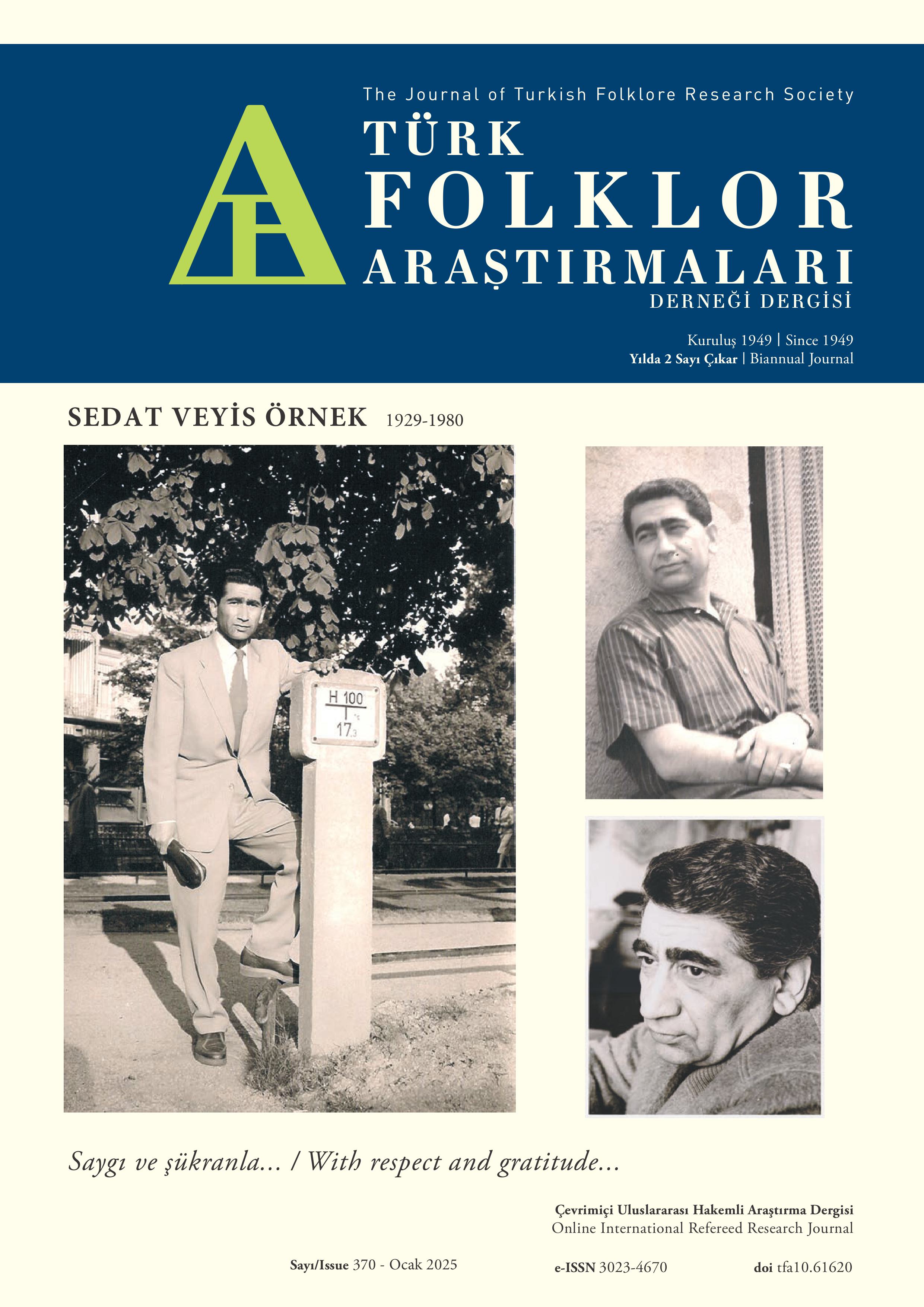An Anthropologist in the 11th Century: Al-Bîrûnî and Tahkîku'l Mâ Li’l-Hind
DOI:
https://doi.org/10.61620/tfa.42Keywords:
anthropology, theory, ethnography, academia, ethics, IndiaAbstract
Al-Biruni, also known as Abu Rayhan Muhammad ibn Ahmad al-Biruni, was born in Khwarezm and was a scientist who excelled in mathematics, as well as medicine, astronomy, physics, natural sciences, and philosophy. Centuries before anthropology was set as a major field of study, following his conquest of India, Sultan Mahmud of Ghazni sent Al-Bîrûnî to India to collect information about this culture. Obeying his orders, long before anthropology's introduction to the academy and buttressed with several ethical rules, Al-Bîrûnî made deep research on the local language, that is Sanscrit, belief, family and social life, numerical system, legislation, astrology and compared them with other cultures like Greek, Roman, Arab, Jewish, Christian and Muslim, wrote his masterpiece called as "Tahkîku'l Mâ Li’l-Hind" (The research on the land of India) between years 1017-1030 A.D. In this article, the work "Tahkîku'l Mâ Li’l-Hind" is examined as an outcome of anthropological research, while Al-Bîrûnî is considered as an anthropologist: Al-Bîrûnî's approach to Indian culture and the method he used in evaluating the culture are discussed comparatively with modern anthropological theories and ethics, especially with Bronislaw Malinowski’s, as he is one of the pioneers in the field.
References
KAYNAKLAR
Acet, M. (2018). Hermeneutik (Yorumbilgisi): Kısa bir tarihçe. Medium. https://medium.com/türkiye/hermeneuti̇k-yorumbi̇lgi̇si̇-kisa-bi̇r-tari̇hçe-82a27cce371a
Ahmed, A. S. (1984). Al-Beruni: The First Anthropologist. RAIN, 60, 9–10. https://doi.org/10.2307/3033407
Alıcı, M. (2003). Bir dinler tarihçisi olarak Bîrûnî ve Tahkîku Ma Li2l-Hind'de Tanrı Kavramına Yaklaşımı. İstanbul Üniversitesi İlahiyat Fakültesi Dergisi, (8), 209-229.
Ataman, K. (2013). İslam düşüncesinde ‘öteki’ni anlama: Bîrûnî Örneği. Milel ve Nihal, 10(3), 201-223.
Aydın, K. & Hanağası, U. B. (2017). Sosyoloji ve siyasal araştırmalarda karşılaştırmalı yöntem. KOSBED 2017, 3: 57-86.
Barış, M. (2018). First translation activities in Islamic science history and their contribution to knowledge production. Cumhuriyet İlahiyat Dergisi, 22(1), 705-730.
Barnard, A. J., & Doğan, M. (2013). Sosyal antropoloji ve insanın kökeni. Boğaziçi Üniversitesi Yayınevi.
Bernard, H. R. (2006). Research methods in anthropology. AltaMira.
Bilim ve Ütopya, Aylık Bilim, Kültür ve Politika Dergisi, Dosya: Tüm zamanların en büyük bilginlerinden Biruni. (2000). 75(Eylül). Ütopya.
Buriev J.A. (2020). Historical and philosophical analysis of Ahmad Zaki Walidi's work "Beruniy." Экономика и социум, 10(77), 44-47.
Duman, A. (2010). Bîrûnî: İlmî kişiliği tarih anlayışı ve yöntemi. Türk Dünyası İncelemeleri Dergisi, 10(2), 19-38.
El-Bîrûnî. (2016). Tahki̇ku ma Li̇'l-Hi̇nd (K. Burslan, Çev., A. İ. Yitik, Ed.). Türk Tarih Kurumu.
Eriksen, T. H. (2018). Küçük yerler büyük meseleler: sosyal ve kültürel antropoloji. (A. E. Koca, Çev.). Birleşik Dağıtım.
Erol, M. & Terzioğlu, A. (2018). Kültür denen şey: Antropolojik Yaklaşımlar (A. Bartu Candan & C. Özbay, Ed.). Metis.
Evans, A. D. (2006). Anthropology at war: Racial Studies of POWs during World War I. Worldly Provincialism: German Anthropology in the Age of Empire, 198-229.
Formichi, Chiara. (2020). Islam and Asia. Cambridge University Press.DOI: 10.1017/9781316226803
Georges, R. A., ve Jones, M. O. (1980). People studying People, The Human Element in Fieldwork. University of California Press.
Ghazni: A city of Empire Builders, Scholars and Monuments. (Aralık 2011). UNESCO. Kabul Unesco Office. https://catalog.acku.edu.af/cgi-bin/koha/opac-detail.pl?biblionumber=37646
Ingold, T. (2018). Art, science and the meaning of research. Research in Arts and Education, 2018(3), 1-9.
Mahoney, J. (2004). Comparative Historical Methodology. Annual Review of Sociology, 30, 81-101. DOI: 10.1146/annurev.soc.30.012703.110507
Malinowski, B. (1990). Büyü, bilim ve din. S. Özkal (Çev.). Kabalcı.
Mathur, H. M. (1972). Anthropology and public administration. Indian Anthropologist, 2(2), 71-79..
Mead, M. (1939). Native languages as field-work tools. American Anthropologist, 41(2), 189-205.
Meyer, M. (2001). Between theory, method, and politics: positioning of the approaches to CDA. R. Wodak, & M. Meyer (Eds.), Methods of Critical Discourse Analysis. Sage, 14-31. doi.org/10.4135/9780857028020.n2
Mosse, D. (2006), Anti-social anthropology? Objectivity, objection, and the ethnography of public policy and professional communities*. Journal of the Royal Anthropological Institute, 12: 935-956. https://doi.org/10.1111/j.1467-9655.2006.00371.x
Okay, Y. (2013). Etnoloji/Etnografya’nın kaynağı olarak seyahatnameler. Türk Yurdu, 310.
OpenAI. (2024). ChatGPT [Large language model]. https://chatgpt.com/c/66e81685-6acc-800b-83ac-72e071ef4f0d
Pišev, M. (2019). Anthropological aspects of Ibn Khaldun’s Muqaddimah: A Critical Examination| Bérose. Un article du dossier documentaire: Ibn Khaldun (1332-1406).
Sachau, E. C. (1910). Alberuni's India: An account of the religion, philosophy, literature, geography, chronology, astronomy, customs, laws and astrology of India About A.D. 1030. Trübner's Oriental Series.
Schultz, E. A., & Lavenda, R. H. (1998). Anthropology. A perspective on the human condition, 2. Mayfield Publishing.
Sparavigna, A. C. (2013). The science of al-Biruni. The International Journal of Sciences. 2, 52-60. https://arxiv.org/pdf/1312.7288.pdf
Sparavigna, A. C. (2014). Al-Biruni and the mathematical geography. PHILICA.1-7. DOI 10.5281/zenodo.3362206
Starr, S.F. (2019). Kayıp aydınlanma: Arap fetihlerinden Timur'a Orta Asya'nın altın çağı. Y. S. İnanç (Çev.). Kronik Kitap.
Uyan-Semerci, P., Erdoğan, E., ve Sandal Önal, E. (2022). Bizliğin aynasından yansıyanlar: Türkiye gerçekliğinde kimlikler ve ötekileştirme. Bilgi Üniversitesi.
Van Dijk, T. A. (2001). Multidisciplinary CDA: A plea for diversity. Methods of critical discourse analysis, 1, 95-120.
Yates, F. A. (2020). Hafıza sanatı. Metis.
Downloads
Published
How to Cite
Issue
Section
License
Copyright (c) 2025 Burcu Asena Salman

This work is licensed under a Creative Commons Attribution 4.0 International License.



